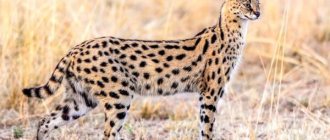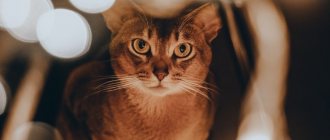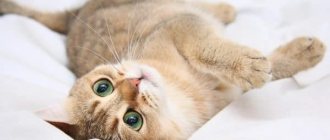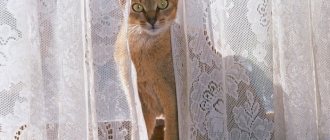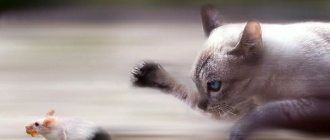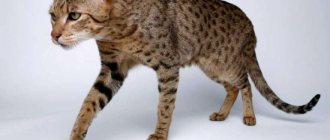- Wild animals
- >>
- Mammals
The Temminck cat , known as the "fire cat" in Thailand and Burma, and as the "stone cat" in some parts of China, is a beautiful wild cat that is medium in size. They make up the second largest category of Asian cats. Their fur varies in color from cinnamon to various shades of brown, as well as gray and black (melanistic).
Origin of the species and description
Photo: Temminka the Cat
Temminck's cat is very similar to the African golden cat, but they are unlikely to be closely related because the forests of Africa and Asia were not connected until more than 20 million years ago. Their similarities are most likely an example of convergent evolution.
The Temminck cat is similar to the Borneo Bay cat in appearance and behavior. Genetic studies have shown that the two species are closely related. The Temminck's cat is found in Sumatra and Malaysia, which was separated from Borneo only about 10,000-15,000 years ago. These observations led to the belief that the Borneo Bay cat is an island subspecies of the Temminck cat.
Video: Temminka's Cat
Genetic analysis has shown that the Temminck's cat, along with the Borneo Bay cat and the marbled cat, diverged from other felids about 9.4 million years ago, and that the Temminck's cat and the Borneo Bay cat diverged as much as four million years ago, suggesting that what the latter was a different species long before Borneo's isolation.
Because of its apparent close relationship with the marbled cat, in some regions of Thailand it is called Seua fai ("fire tiger"). According to regional legend, burning the fur of Temminck's cat drives away tigers. Eating meat is believed to have the same effect. Karens believe that it is enough to carry only one cat's fur with you. Many indigenous people consider the cat to be ferocious, but in captivity it is known to be docile and calm.
In China, Temminck's cat is considered a kind of leopard and is known as the "stone cat" or "yellow leopard". The different color phases have different names: cats with black fur are called "ink leopards", while cats with spotted fur are called "sesame leopards".
Interesting fact: The cat was named after the Dutch zoologist Coenraad Jacob Temminck, who first described the African golden cat in 1827.
Is it possible to keep Temminka at home?
The Temminck cat is a wild animal, its temperament is not suitable for domestic living and it is practically impossible to tame and socialize due to its fearfulness and caution.
Currently, only a limited number of individuals are kept in zoos, nature reserves and specialized nurseries.
In Russia there are only two cats of different sexes in the Novosibirsk Zoo. It is noted that the individuals living in the enclosure allocated for them do not show any aggression towards the workers, but they are not interested in humans, do not strive for communication, they are calm and restrained in behavior.
Rare breeders note that even a kitten raised in captivity and weaned from its mother early as an adult should be kept only in a spacious enclosure, as it can be dangerous to humans.
With puberty, all the instincts of a predator awaken in a cat and, although the pet will never attack first, it is impossible to predict its behavior.
Perhaps over time, when several generations of these rare cats can be obtained in captivity, it will be possible to obtain hybrid varieties of Temminki that will be prone to socialization. After all, such experiences in the conditions of foreign breeding are not uncommon. These are the well-known Bengals (with the wild Bengal cat), Chausie (with the reed or swamp house cat), and Caraquets (with the caracal).
Appearance and features
Photo: What Temminka's cat looks like
The Temminck cat is a medium-sized cat with relatively long legs. It is similar in appearance to the African golden cat (Caracal aurata), but recent genetic analyzes indicate that it is more closely related to the Borneo Bay cat (Catopuma badia) and the marbled cat (Pardofelis marmorata).
There are two subspecies of the Temminck cat:
- catopuma temminckii temminckii in Sumatra and the Malay Peninsula;
- catopuma temminckii moormensis from Nepal to Northern Myanmar, China, Tibet and Southeast Asia.
The Temminck cat is surprisingly polymorphic in its color. The most common coat color is golden or red-brown, but it can also be dark brown or even gray. Melanistic individuals have been recorded and may be predominant in some areas of its range.
There is also a spotted form called the "ocelot morph" because of its rosettes, similar to those of the ocelot. To date, this form has been reported from China (in Sichuan and Tibet) and Bhutan. The most distinctive features of this cat are the white lines bordering dark brown to black running across the cheeks, from the nostrils to the cheeks, at the inner corner of the eyes and up the top of the head. The rounded ears have black backs with a gray patch. The chest, abdomen and inner side of the legs are white with light speckles. The legs and tail are gray to black at the distal ends. The terminal half of the tail is white on the underside and often has a tip curled at the top. Males are larger than females.
History of the discovery of the margay species
The margay (Leopardus wiedii or Felis wiedii) is an American wild cat that lives in the moist evergreen forests of South and Central America.
Margay is an American cat
The researcher named the long-tailed cat in honor of Prince Maximilian Wied-Neuwied, who spent his entire life collecting specimens of wild and rare animals in Brazil.
There are several subspecies of margay
There are more than 10 known subspecies of the long-tailed wild cat, the most common of which are:
- Leopardus wiedii wiedii (Brazil, Paraguay, Uruguay, Argentina).
- Leopardus wiedii amazonica (Brazil, Peru, Colombia and Venezuela).
- Leopardus wiedii boliviae (Bolivia).
- Leopardus wiedii cooperi (Mexico).
- Leopardus wiedii glaucula (Mexico).
- Leopardus wiedii nicaraguae (Honduras, Nicaragua, Costa Rica).
- Leopardus wiedii oaxacae (Mexico).
- Leopardus wiedii pirrensis (Panama, Colombia, Ecuador, Peru).
- Leopardus wiedii salvinia (Chiapas, Guatemala, El Salvador).
- Leopardus wiedii yucatanica (Yucatan).
The main differences between subspecies are color. This is due to the fact that, depending on their habitat, wild animals try to “merge” with the landscape.
Where does Temminka the cat live?
Photo: Temminka's cat in nature
The distribution of the Temminck's cat is similar to that of the mainland clouded leopard (Neofelis nebulosa), the Sunda clouded leopard (Neofelis diardi) and the marbled cat. It prefers tropical and subtropical moist evergreen forests, mixed evergreen forests and dry deciduous forests. Found in the foothills of the Himalayas in China and Southeast Asia. It is also found in Bangladesh, Bhutan, Cambodia, India, Indonesia, Lao People's Democratic Republic, Malaysia, Myanmar, Nepal, Thailand and Vietnam. Temminck's cat is not found in Borneo.
In India, it has been reported only in the northeastern states of Assam, Arunachal Pradesh and Sikkim. More open habitats such as shrubland and grassland, or open rocky areas, have been reported from time to time. The species has also been detected using camera traps located on or near oil palm and coffee plantations in Sumatra.
Fun fact: Although Temminck cats can climb well, they spend most of their time on the ground with their long tail curled at the tip.
Temminck's cat is often recorded at relatively high altitudes. It has been observed at altitudes up to 3050 m in Sikkim, India, and in Jigme Sigye Wangchuck National Park in Bhutan at 3738 m in the dwarf rhododendron and grassland areas. The altitude record is 3960 m, where the Temminka cat was discovered in the Khangchendzong Biosphere Reserve, Sikkim, India. However, in some areas it is more common in lowland forests.
In Kerinci Seblat National Park in Sumatra, it was only recorded by camera traps at low altitudes. In the mountain forests of India's western Arunachal Pradesh province, Temminck's cat has not been recorded by camera traps, despite the appearance of marbled cats and clouded leopards.
Now you know where the wild cat Temminika is found. Let's see what this Asian golden cat eats.
Number of golden Asian cat
Uncontrolled deforestation of tropical forests and poaching have a significant impact on the population size of the Asian golden cat. Due to the fact that the meat of this animal is eaten by the Chinese and is considered a local delicacy, and also because its bones are used in medicine (to treat fever in children), this rare cat is mercilessly exterminated. Since the predator sometimes attacks domestic animals, the local population also kills these animals. Today there are no more than ten thousand individuals.
The population of Asian cats is steadily declining
To protect and preserve the population of the Asian fiery cat, the World Conservation Organization was created, which includes various governmental and non-governmental agencies.
The Asian Temminka cat is on the verge of extinction. Therefore, it is included in the CITES Convention (Appendix 1) and the International Red Book.
What does the Temminka cat eat?
Photo: Wild cat Temminka
Like most cats their size, Temminck cats are carnivores, often eating small prey such as Indochinese ground squirrels, small snakes and other amphibians, rodents, and young hares. In Sikkim, India, in the mountains, they also hunt larger animals such as wild pigs, water buffalo and sambar deer. Where humans are present, they also hunt domesticated sheep and goats.
Temminck's cat is primarily a terrestrial hunter, although locals claim that she is also a skilled climber. It is believed that the Temminka cat hunts mainly large rodents. However, it is also known to prey on reptiles, small amphibians, insects, birds, poultry and small ungulates such as muntjac and chevrotain.
Temminck cats have been reported to hunt larger animals such as:
- gorals in the mountains of Sikkim, India;
- wild pigs and sambar in Northern Vietnam;
- young domestic buffalo calves.
An analysis of stingrays in Taman Negara National Park on Peninsular Malaysia found that the cats also prey on species such as the dusky monkey and mouse. In Sumatra, there have been reports from local residents that Temminck cats sometimes prey on birds.
In captivity, Temminck cats are fed a less varied diet. They were given animals with less than 10% fat because too much fat causes animals to vomit. Their food is also fortified with aluminum carbonate and multivitamin supplements. "Dead whole foods" that have been introduced to animals include chicken, rabbits, guinea pig, rats and mice. In zoos, Temminck cats receive from 800 to 1500 kg of food per day.
Life in captivity
Zoos around the world contain several dozen individuals of this species. According to experts, black-footed cats are of much more scientific than exhibition value - they are quite unsociable and almost never show themselves to visitors during the day, leaving their hiding places only at night.
Content Features
Despite the fact that the species is rightfully considered rare, keeping its representatives in captivity is not particularly difficult. The African cat has good health and high resistance to diseases. It is unpretentious in nutrition and does not require overly spacious, specially equipped enclosures. The lifespan of a predator in a zoo can reach fifteen years.
This species is very rare not only in the wild, but also in zoos
Zoologists are considering the possibilities of reproducing a rare species in captivity using the most advanced scientific techniques. In 2011, the Endangered Species Research Center (USA) carried out a successful experiment that had been prepared for seven years - it used frozen embryos and the method of artificial insemination. Two spotted brothers were born “from a test tube” by a surrogate mother - a black-footed cat named Bijou.
“Test Tube Brothers” was born and raised by a surrogate mother
As for taming an animal, any attempts to domesticate a wild cat are doomed to failure - the genetics of a predator are too strong in it. For this reason, the black-footed cat is very rarely kept in private zoos, which is more likely to benefit it than to harm it.
Video: they play like ordinary kittens
Unfortunately, we know too little about the real life of the black-footed cat. And while scientists are implementing programs to reproduce the species, its actual natural population is decreasing day by day. If this small mysterious beast disappears from the face of the planet without a trace, its fauna will become significantly impoverished.
Features of character and lifestyle
Photo: Golden cat Temminka
Little is known about the behavior of Temminck's cat. It was once thought to be primarily nocturnal, but recent evidence indicates that the cat may be more crepuscular or diurnal. Two radio-collared Temminck cats in Thailand's Phu Khieu National Park showed mostly diurnal and crepuscular activity peaks. Additionally, most of the Temminka cat photos were taken during the day in Kerinci Seblat and Bukit Barisan Selatan National Parks in Sumatra.
The range of two Temminck radar cats in Thailand in Phu Khieu National Park was 33 km² (female) and 48 km² (male) and overlapped significantly. In Sumatra, a radio-collared female spent much of her time outside the protected area in small patches of remnant forest located among coffee plantations.
Fun fact: Temminck cat vocalizations include hissing, spitting, meowing, purring, growling and gurgling. Other communication methods observed in Temminck cats in captivity include scent marking, urine spraying, raking trees and logs with their claws, and head rubbing against various objects, very similar to the behavior of a domestic cat.
Description of the Kalimantan cat
This rare cat species belongs to the genus Catopuma. In 2007, the estimated number of these individuals was established as 2,500. As already noted, very little has been studied about this cat family. The Borneo beauty looks like a large domestic cat with a long body and tail. Her ears are round, located on the sides of her head, and not on top. This property sets it apart from other wild species. This predator also has a rounded skull shape.
The color of the Borneo beauty's thick, shiny coat varies within the orange-brown palette: sometimes it is gray-black, but more often red-brown. The color of this mysterious animal is evenly distributed on the sides and back. The chest, chin and underbelly are slightly lighter. Two dark brown stripes are located on the predator’s cheeks and forehead. They give the cat a predatory look. There are pale black spots along the glossy fur of the back and belly. Another feature: the direction of the fur on the cheeks, throat and back of the head points forward, not back.
The back of the animal's head is distinguished by an M-shaped marking; the top of the head is gray-brown in color. The Borneo beauty has dark brown ears and a long tail that tapers to a point.
Social structure and reproduction
Photo: Temminka cat kitten
Not much is known about the reproductive behavior of this rather elusive cat in the wild. Most of what is known has been extracted from cats in captivity. Female Temminck cats are sexually mature between 18 and 24 months, and males are sexually mature at 24 months. Females enter estrus every 39 days, after which they leave markings and seek contact with the male by adopting receptive postures. During sexual intercourse, the male will grab the female's neck with his teeth.
After a gestation period of 78 to 80 days, the female gives birth to a litter of one to three kittens in a protected location. Kittens weigh between 220 and 250 g at birth, but triple that during the first eight weeks of life. They are born with the adult fur pattern and open their eyes after six to twelve days. In captivity they live up to twenty years.
Temminck's cat at the Washington Park Zoo (now the Oregon Zoo) showed a sharp increase in the frequency of odor production during estrus. At the same time, she often rubbed her neck and head with inanimate objects. She also repeatedly approached the caged male, rubbed him, and assumed a receptive posture (lordosis) in front of him. During this time, the male's scent speed increased, as did the frequency of his approaching and following the female. The male's superficial behavior included biting the back of the head, but unlike other small felids, the bite was not sustained.
A couple at the Washington Park Zoo produced 10 litters, each consisting of one kitten; two litters of the same kitten, each born at Wassenaar Zoo in the Netherlands, one kitten was registered from the other litter. Two litters of two kittens were born at a private cat breeding facility in California, but neither survived.
Lion (Panthera leo)
Representatives of this species are among the largest cats existing at the moment. The body weight of individual males reaches 250 kg or more. The length of the powerful muscular body of the predator is up to 3 meters, the tail reaches up to 90 cm. Females are somewhat smaller in size and their weight rarely exceeds 180 kg.
The appearance of the animal is very peculiar. In addition, it is one of the few species with clearly visible sexual dimorphism. The males of these cats differ not only in weight and body size, but also in the presence of a mane. Its fur covers the head, part of the back, chest and shoulders of the animal. The animal's skin is covered with short, sandy-gray hair. The thick mane can be either the same shade as the main color, or darker, even black. There is a tassel at the tip of the tail.
The predator's habitat has undergone dramatic changes under human influence. Previously, the distribution area of this species was much wider; for example, cats could be found in the Middle East and in the southern part of modern Russia. Now the animals can be found in sub-Saharan Africa. A small number of individuals live in the Gir Forest in the south of the Kathiyawar Peninsula.
Unlike other representatives of the cat family, lions are social animals and they live in entire groups called prides. Most often, a lion family consists of cubs, several related females and 1-2 adult males. All females are involved in feeding and protecting the young, regardless of whose litter it is. If one of the mothers dies for some reason, her kittens are raised by the others. The pride is reluctant to accept females from outside. Young, grown-up males are expelled from the pack, after which, at the call of instinct, they look for families of lionesses and fight for dominance in the new pride.
The pride hunts at dusk, while during the daytime the cats prefer to rest in the shade. Mostly females take the prey; lions rarely take part in this event. When hunting for large prey, the pride tries to isolate it from the herd, after which they attack and kill it. A lion family could target a buffalo, wildebeest or zebra.
Natural enemies of Temminck cats
Photo: Dangerous cat Temminka
There is a general lack of information about Temminck cat populations and their status, as well as a low level of public awareness. However, the main threat to the Temminck's cat appears to be habitat loss and modification due to deforestation in tropical and subtropical forests. Southeast Asia's forests are experiencing the world's highest rates of regional deforestation, thanks to the expansion of oil palm, coffee, acacia and rubber plantations.
The Temminck cat is also threatened by hunting for its skin and bones, which are used in traditional medicine, as well as its meat, which is considered a delicacy in some areas. In some regions, people believe that consuming Temminck cat meat increases strength and energy. Poaching of the species is believed to be increasing in many areas.
The cat fur trade has been observed along the Myanmar-Thailand border and in Sumatra, as well as in areas in northeastern India. In southern China, Temminck cats have become increasingly sought after for this purpose as significant declines in tiger and leopard populations have shifted emphasis to smaller felid species. Locals follow Temminck's cats and set traps or use hunting dogs to find and corner them.
The species is also threatened by indiscriminate fishing and declining prey numbers due to high hunting pressure. Locals follow the tracks of golden cats and set traps or use hunting dogs to find and corner the Asian golden cat. The species is also threatened by indiscriminate fishing and declining prey numbers due to high hunting pressure. Locals follow the tracks of golden cats and set traps or use hunting dogs to find and corner the Asian golden cat.
The Asian golden cat is also killed in retaliation for the destruction of livestock. A study conducted in villages around Bukit Barisan Selatan National Park in Sumatra found that the Temmincka cat sometimes preyed on poultry and was often persecuted as a result.
Purchasing a Temminka kitten
This animal is now listed in the first CITES appendix, and smuggling is subject to a large fine and even imprisonment. Even large zoos find it difficult to acquire these rare and unique animals.
Only from single foreign breeders, with a long and persistent search, can you find “legitimate” kittens born from cats who themselves grew up in captivity and have all the necessary documents about their origin.
The cost of a kitten starts from 7-10 thousand dollars.
In order to seriously engage in breeding the Temminka Cat and its hybrid species in captivity, a person, first of all, needs to restore the natural population and stop the extinction of this rare animal.
For this purpose and to stop the deforestation of rare tropical forests, various associations have been created, including the World Conservation Organization, which includes a number of government and public companies.
1111
Population and species status
Photo: What Temminka's cat looks like
The Temminck's cat is listed as critically endangered, but there is little specific information about the species available and therefore its population status is largely unknown. In some areas of its range this appears to be relatively uncommon. This cat has been rarely reported in southern China, and the Temminck's cat was thought to be less common than the clouded leopard and leopard cat in the region.
Temminck's cat is found infrequently in eastern Cambodia, Laos and Vietnam. The last record from Vietnam dates back to 2005, and in the Chinese provinces of Yunnan, Sichuan, Guangxi and Jiangxi, the species was only found three times during extensive surveys. However, in other areas it appears to be one of the most common small cat species. Studies in Laos, Thailand and Sumatra have shown that the Temminck's cat is more common than sympatric felids such as the marbled cat and the mainland clouded leopard. The species' distribution is limited and patchy in Bangladesh, India and Nepal. It is more widely distributed in Bhutan, Indonesia, Malaysia, Myanmar and Thailand. Overall, Temminck's cats are believed to be in decline across their range due to significant habitat loss and ongoing illegal poaching.
Area
Temminck cats are found in the Eastern region and parts of the Palaearctic, southwest Asia, ranging from China and India, through the Malay Peninsula, Thailand and Vietnam. Although the presence of vegetation and adaptation to different environments should make this species thriving, their range is decreasing with increased human activity and high levels of poaching. Currently, these cats can be found in the Phu khieo Wildlife Sanctuary and the Jerangau Forest Reserve.
Taxonomy
Felis Temminki
was the scientific name used in 1827 by Nicholas Aylward Vigors and Thomas Horsfield who described tawny cat skin from Sumatra.[3]
Felis moormensis
proposed by Brian Houghton Hodgson in 1831. The young cat was caught alive by Murmi hunters in Nepal.[4]
Felis Tristis
, proposed by Alphonse Milne-Edwards in 1872, was a spotted Asian golden cat from China.[5]
He was subordinated to the family of Katopum
proposed by Nikolai Severtsov in 1853.[6]Two subspecies are recognized as valid from 2022:[7]
- C.t.
Temminckii occurs in Sumatra and the Malay Peninsula - C.t.
Moormensis occurs from Nepal east to Southeast Asia
Phylogeny
Phylogenetic analysis of nuclear DNA in tissue samples from all Felidae species revealed that the evolutionary radiation of Felidae originated in Asia during the Miocene around 14.45–8.38 million years ago.[8][9] Mitochondrial DNA analysis of all Felidae species indicates radiation at levels around 16.76 to 6.46 million years ago.[10]The Asian golden cat forms an evolutionary lineage along with the bay cat ( C. badia
) and the marbled cat (
Pardofelis marmorata
), which diverged from a common ancestor between 8.42–4.27 million years ago, based on analysis of their nuclear DNA.[8][9] Analysis of their mitochondrial DNA indicates a genetic divergence from their common ancestor between 8.47–0.41 million years ago. [10] Both models agree that the marbled cat is the first species of this lineage to diverge, while the Asian the golden cat and the bay cat diverged from each other approximately 6.42 to 0.03 million years ago[8][10]
The following cladogram shows the phylogenetic relationships of the Asian golden cat:[8][9][10]
| Feline | |
| bay cat | |
Characteristics
Illustration of Asian golden cat skulls (bottom) and fishing cat (top)[11] Gray transformation of the Asian golden cat, Arunachal Pradesh, India The
Asian golden cat is a medium-sized cat with a head to body length of 66–105 cm (26–41 in), with a long tail of 40–57 cm (16–22 in) and measuring 56 cm (22 in) shoulder height. It ranges in weight from 9 to 16 kg (20 to 35 lb), which is about two or three times that of the domestic cat ( Felis catus
).[2]
The Asian golden cat is polymorphic in color. Golden, reddish-brown and dark brown specimens have been recorded in northeastern India and Bhutan.[12][13][14][15][16]Reddish-brown morphs have been recorded in Sumatra.[3][17][18 Melanistic individuals have been recorded in the eastern Himalayas,[12][13][19] and Sumatra.[17] The spotted Asian golden cat with large rosettes on the shoulders, flanks and hips was first described from a specimen from China in 1872 .[5] This morph has been recorded in China, Bhutan and in West Bengal's Buxa Tiger Reserve.[20][21][16]
Blue Bengal cat
Blue color (d, d dilute genes) is very rare, but some breeders are working hard to try to promote blue Bengals to championship status.
Blue Bengal cats are blue-gray in color with cream tones. Mottled or marbled pattern - dark blue or metallic gray.
Since this is a regenerative gene, both parents must be blue to produce a blue Bengal cat.
Blue Bengals also have:
– Steely blue background color – Blue markings that never turn black – Dark gray tail – Gold, green or brown eyes
Dangerous and freedom-loving
In Thailand there is a belief that this small creature can take on a tiger. In Thai fairy tales, it is endowed with remarkable intelligence, courage and ferocity. Its skin is used by Thais to repel striped predators. In addition, they consider the fur of a fire cat to be a powerful amulet. In their opinion, one hair is enough to drive away a tiger or not have major problems with bandits, the tax inspectorate or the police.
Eating its meat has a similar effect, which is why it is highly valued in local cuisine, but is very expensive and available only to the cream of society. In Chinese folk medicine, bones are primarily valued. Powder from them is included in many medicinal potions for diseases of the musculoskeletal system.
In captivity, Temminck cats reproduce very poorly. In zoos around the world, only five females were able to produce offspring. Males deprived of freedom usually kill females sooner or later and flatly refuse to produce offspring in a cage.
Threats
The Asian golden cat is one of the fastest growing countries in the world, where it is increasingly threatened by habitat destruction following deforestation, along with a shrinking ungulate prey base. He was reportedly killed in Sumatra in revenge for hunting poultry. In Southeast Asia and China it is threatened by poaching for the illegal wildlife trade.[1] This trade has the greatest potential to cause maximum harm in the minimum amount of time.[22]
Illegal wildlife trade
Asian golden cats are poached primarily for their fur.[41] In Myanmar, 111 body parts of at least 110 individuals were observed in four markets surveyed between 1991 and 2006. Their numbers were significantly higher than those of non-threatened species. Among the observed skins was a specimen with ocelot-like rosettes - a Tristis
form. Three of the markets studied are located on the international borders of China and Thailand and cater to international buyers, although the Asian golden cat is fully protected under Myanmar's national laws. Effective implementation and enforcement of CITES is considered inadequate.[42]
Recommendations
- ^ a b c d
McCarthy, J.;
Dahal, S.; Dhendup, T.; Gray, T. N. E.; Mukherjee, S.; Rahman, H.; Riordan, P.; Buntua, N., and Wilcox, D. (2015). " Catopuma temminckii
".
IUCN Red List of Threatened Species
.
2015
: e.T4038A97165437. - ^ a b c d e
Sanquist, M., Sanquist, F. (2002).
"The Asian golden cat Catopuma temminckii
(Vigors and Horsfield, 1827)."
Wild cats of the world
. Chicago: University of Chicago Press. pp. 52–56. ISBN 0-226-77999-8. - ^ a b
Vigors, N. A. & Horsfield, T. (1827).
"Description of two species of the genus Felis
, in the collections of the Zoological Society."
Zoological Journal
.
III
(11):449–451. - ^ a b
Hodgson, B. H. (1831).
"Some information about a new species of Felis". Collections in Science
.
III
(30): 177–178. - ^ a b
Milne-Edwards, A. (1872).
" Felis Tristis
, Nov.
sp. ". Étude pour servir à l'histoire de la faune mammalogique de la Chine.
Recherches pour servir à l'histoire des mammifères comprenant des considérations sur la classification de ces animaux . Paris: J. Masson. pp. 223-224. - Severtsov, M. N. (1858). "Notice on the multifaceted classification of carnivores, on special animals, and on studies of general zoology that bear the rat." Revue et Magasin de Zoologie Pure et Appliquée
.
X
: 385–396. - Kitchener, A. S.; Breitenmoser-Würsten, C.; Eizirik, E.; Gentry, A.; Werdelin, L.; Wilting, A.; Yamaguchi, N.; Abramov, A. V.; Christiansen, P.; Driscoll, C.; Duckworth, J. W.; Johnson, W.; Luo, S.-J.; Meijaard, E.; O'Donoghue, P.; Sanderson, J.; Seymour, K.; Bruford, M.; Groves, C.; Hoffmann, M.; Nowell, K.; Timmons, Z., & Tobe, S. (2017). "Revised Taxonomy of Felids: Final Report of the IUCN Felid Specialist Group Task Force on Cat Classification" (PDF). Cat News
. Special Issue 11: 36-37. - ^ a b c d
Johnson, W. E.;
Eizirik, E.; Pecon-Slattery, J.; Murphy, W. J.; Antunes, A.; Teeling, E., & O'Brien, S. J. (2006). "Late Miocene radiation of modern felids: a genetic assessment". The science
.
311
(5757):73–77. Bibcode:2006 Science ... 311 ... 73J. Doi:10.1126/science.1122277. PMID 16400146. S2CID 41672825. - ^ a b c
Werdelin, L.;
Yamaguchi, N.; Johnson, W. E., & O'Brien, S. J. (2010). "Phylogeny and evolution of cats (Felidae)". In Macdonald, D. W. & Loveridge, A. J. (eds.). Biology and Conservation of Wild Felids
. Oxford, UK: Oxford University Press. pp. 59–82. ISBN 978-0-19-923445-5. - ^ a b c d
Li, G.;
Davis, B.W.; Eizirik, E., & Murphy, W. J. (2016). "Phylogenomic evidence for ancient hybridization in the genomes of living cats (Felidae)". Genomic Research
.
26
(1): 1–11. Doi:10.1101 / gr.186668.114. PMC 4691742. PMID 26518481. - Pocock R.I. (1939). "Rod Profelis
Severtsov."
Fauna of British India, including Ceylon and Burma.
Mammalia. — Volume 1 . London: Taylor and Francis, Ltd., pp. 258–266. - ^ a b c
Bashir, T.;
Bhattacharya, T.; Poudyal, K. and Satyakumar, S. (2011). "Notable observations of the melanistic Asian golden cat ( Pardofelis temminckii
) of Sikkim, India."
NeBIO
.
2
(1): 2–4. - ^ a b
Jigme, K. (2011).
"Four color transformations and altitude recording of the Asian golden cat in Bhutan." Cat News
(55): 12–13. - ^ a b
Nadig, S.;
R., N.; Silva, A. P. (2016). "Small Cats in the Himalayan Foothills: Asian Golden Cat from Nonghillem Wildlife Sanctuary, India" (PDF). Small Wild Cat Conservation News
.
2:23
. Archived from the original (PDF) on 2016-10-06. Retrieved 2017-01-01. - Mukherjee, S.; Choudhary, P.; Arthreya, R., and Karunakaran, P. V. (2018). "The Tale of Tails is an attempt to decipher the distribution of small cats by tail length." In Appel, A.; Mukherjee, S. and Chain, S. M. (Eds.). Proceedings of the First International Small Wild Cat Conservation Summit, 11–14 September 2022, United Kingdom
. Bad Marienberg, Germany; Coimbatore, India; Oxford, UK: Wildcat Network; Salim Ali Center for Ornithology and Natural History; Borneo Nature Trust. pp. 11–12. - ^ a b c
Ghose, M.;
Sharma, D., and Murali, N. S. (2019). “First photographic evidence of a polymorphic Asian golden cat. Catopuma temminckii
Vigors & Horsfield, 1827 (Mammalia: Carnivora: Felidae) in Buxa Tiger Sanctuary, West Bengal, India."
Journal of Taxa Threats
.
11
(4):13502–13505. Doi:10.11609/jott.4254.11.4.13502-13505. - ^ a b c
Holden, J. (2001).
"Small cats in Kerinci Seblat National Park, Sumatra, Indonesia." Cat News
(35): 11–14. - Haidir, I.A.; Dinata, Y.; Linkey, M., & McDonald, D. W. (2013). "Habitat area of the Asian golden cat and Sunda clouded leopard in the Kerinci Seblat landscape, west-central Sumatra." Cat News
(59): 7–10. - ^ a b
Ghimiray, Y. & Pal, P. (2009).
"First camera trap image of an Asian golden cat in Nepal" (PDF). Cat News
(51): 17. Archived from the original (PDF) on 2011-07-26. Retrieved 2017-07-10. - Jutzeler, E.; Xie, Y., & Vogt, C. (2010). "Asian golden cat in China." Cat News
(Special Issue 5): 40–41. - ^ a b c
Wang, S. W. (2007).
"A rare species of Asian golden cat in Jigme Singye Wangchuck National Park in Bhutan." Cat News
(47): 27–28. - ^ a b c d
Nowell, K.;
Jackson, P. (1996). "Asian golden cat, Catopuma temmincki
(Vigors and Horsfield, 1827)."
Wildcats: A Status Review and Conservation Action Plan
. Gland, Switzerland: IUCN/SSC Cat Specialist Group. pp. 69−70. - Ellerman, J. R.; Morrison-Scott, T.S.S. (1966). " Felis Temminki
Vigors and Horsfield, 1827."
Checklist of mammals of the Palaearctic and India from 1758 to 1946
(Second ed.). London: British Museum. pp. 311−312. - Koju, N.P.; Bashyal, B.; Pandey, B.P.; Thami, S.; Dhamala, M.K. & Shah, S. (2020). "New record for Asian golden cat Catopuma temminckii
Vigors & Horsfield, 1827 (Mammalia: Carnivora: Felidae): photographic evidence of its westernmost distribution in Gaurishankar Wildlife Sanctuary, Nepal."
Journal of Taxa Threats
.
12
(2):15256–15261. Doi:10.11609/jott.5227.12.2.15256-15261. - Chowdhury, A. (2007). "Encountering an Asian golden cat in the grasslands of Manas National Park in Assam." Cat News
(47): 29. - Gouda, J.; Sethi, J. & Chauhan, N. P. S. (2016). "First photograph of an Asian golden cat in Dampa Tiger Reserve, Mizoram, India." Cat News
(64): 26–27. - ^ a b
Mukherjee, S.;
Singh, P.; Silva, A.; Ri, C.; Kakati, K.; Borah, B.; Tapi, T.; Kadur, S.; Choudhary, P.; Srikanth, S.; Nadig, S.; Navya, R.; Björklund, R.; Ramakrishnan, U. (2019). "Patterns of activity of a guild of small and medium-sized felids (Mammalia: Carnivora: Felidae) in northeastern India." Journal of Taxa Threats
.
11
(4): 13432−13447. Doi:10.11609/jott.4662.11.4.13432-13447. - Rao, M.; Than Myint; Than Zaw; Saw Htun (2005). "Hunting patterns in the rainforest adjacent to Hkakaborazi National Park, northern Myanmar." Oryx
.
39
(3):292–300. Doi:10.1017/S0030605305000724. - Saw Sha Bwe Mu; Froese, G. Z. L.; Gray, T. N. E. (2017). “The first structured camera trap surveys in Karen State, Myanmar, reveal a high diversity of endangered mammals.” Oryx
.
52
(3): 537−543. Doi:10.1017/S0030605316001113. - Duckworth, J. W.; Salter, R.E.; Khunbolin K. (compilers) (1999). Wildlife in the Lao People's Democratic Republic: Status Report 1999
(PDF). Vientiane: IUCN - World Conservation Union, Wildlife Conservation Society, Center for Protected Areas and Watershed Management. Archived from the original (PDF) on 2011-10-04. Retrieved 2010-11-06. - Johnson, A.; Vongkhamheng, C.; Saihongdam, T. (2009). "Diversity, status and conservation of small carnivores in a montane rainforest of northern Laos" (PDF). Oryx
.
43
(4):626–633. Doi:10.1017/S0030605309990238. - Li, S.; Wang, D.; Lu, Z.; Mac Shea, W. J. (2010). "Cats Living with Pandas: Status of Wild Felids within the Range of Giant Pandas, China." Cat News
(52): 20–23. - Pusparini, W.; Wibisono, H. T.; Reddy, G. V.; Tarmizi; Bharata, P. (2014). "Small and medium-sized cats in Gunung Leuser National Park, Sumatra, Indonesia." Cat News
(Special Issue): 4–9. - Weiskopf, S. R.; McCarthy, J. L.; McCarthy, K. P.; Shiklomanov, A. N.; Wibisono, H. T.; Pusparini, V. (2019). "Conserving the value of forest fragments in an increasingly agrarian landscape in Sumatra." Environmental protection
.
46
(4): 340–346. Doi:10.1017/S0376892919000195. - Grassman Jr., L.I.; Tewes, M. E.; Silvy, N.J.; Kritiyuthanont, K. (2005). "Ecology of three sympatric felids in a mixed evergreen forest in North-Central Thailand" (PDF). Journal of Mammology
.
86
(1):29–38. Doi:10.1644 / 1545-1542 (2005) 086 2.0.CO; 2. - Dong Yin (1967). Wild animals of Burma.
Rangoon Gazette Ltd., Rangoon. - Biswas, B., & Ghosh, R. K. (1982). Progress report 1 on a pilot study of a joint WWF-India/Zoological Survey of India project to study the status of small cats in eastern India.
Zoological Survey of India, Kolkata. - Jones, M. (1977). Accounting and longevity of felines in captivity.
In: Eaton, R.L. (ed.)
Cats of the World.
Vol. 3, no. 3. Seattle: Carnivore Research Institute, Burke Museum, University of Washington. - Mellen, J. (1989). Reproductive behavior of small cats in captivity (Felis ssp.).
PhD. completed his dissertation at the University of California, Davis. - Prator, T., Thomas, W. D., Jones, M. and M. Dee (1988). A twenty-year review of selected rare raptors in captivity.
pp. 191–229.
In B. Dresser, R. Rees and E. Maruska (eds.) Proceedings of the 5th World Conference on Captive Breeding of Threatened Species.
Cincinnati, Ohio. - Lynam, A. J.; Round, P.; Brockelman, W. Y. (2006). Status of birds and large mammals in the Dong Payayen-Khao Yai forest complex, Thailand
(PDF). Bangkok, Thailand: Biodiversity Research and Training Program and Wildlife Conservation Society. Archived from the original (PDF) on 2011-07-27. Retrieved 2010-11-06. - Shepherd, C. R.; Nijman, W. (2008). Trade in wild cats in Myanmar
(PDF). Petaling Jaya, Selangor, Malaysia: TRAFFIC Southeast Asia. - EAZA Felid TAG (2009). EAZA Felid TAG Annual Report 2007-2008.
Archived July 20, 2011. Wayback Machine. In: EAZA Yearbook 2007/2008. European Association of Zoos and Aquariums - Lekagul, B.; McNeely, J. (1977). Mammals of Thailand
. Bangkok: Wildlife Conservation Association. - “เสือไฟ กัด ช้าง ตาย.” Bangkokbiznews
(in Thai). 2015. Retrieved 2017-08-01.

